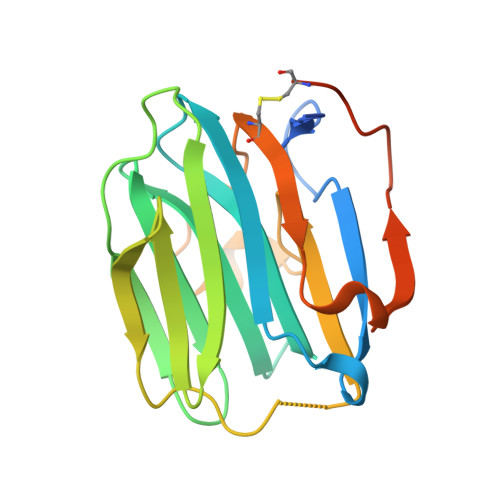Steroid-binding specificity of human sex hormone-binding globulin is influenced by occupancy of a zinc-binding site.
Avvakumov, G.V., Muller, Y.A., Hammond, G.L.(2000) J Biol Chem 275: 25920-25925
- PubMed: 10859323
- DOI: https://doi.org/10.1074/jbc.M004484200
- Primary Citation of Related Structures:
1F5F - PubMed Abstract:
One calcium-binding site (site I) and a second poorly defined metal-binding site (site II) have been observed previously within the amino-terminal laminin G-like domain (G domain) of human sex hormone-binding globulin (SHBG). By soaking crystals of this structure in 2.5 mm ZnCl(2), site II and a new metal-binding site (site III) were found to bind Zn(2+). Site II is located close to the steroid-binding site, and Zn(2+) is coordinated by the side chains of His(83) and His(136) and the carboxylate group of Asp(65). In this site, Zn(2+) prevents Asp(65) from interacting with the steroid 17beta-hydroxy group and alters the conformations of His(83) and His(136), as well as a disordered region over the steroid-binding site. Site III is formed by the side chains of His(101) and the carboxylate group of Asp(117), and the distance between them (2.7 A) is increased to 3.7 A in the presence of Zn(2+). The affinity of SHBG for estradiol is reduced in the presence of 0. 1-1 mm Zn(2+), whereas its affinity for androgens is unchanged, and chemically-related metal ions (Cd(2+) and Hg(2+)) have similar but less pronounced effects. This is not observed when Zn(2+) coordination at site II is modified by substituting Gln for His(136). An alteration in the steroid-binding specificity of human SHBG by Zn(2+) occupancy of site II may be relevant in male reproductive tissues where zinc concentrations are very high.
Organizational Affiliation:
Departments of Obstetrics & Gynecology and Pharmacology & Toxicology and Medical Research Council Group in Fetal and Neonatal Health and Development, University of Western Ontario, London, Ontario N6A 4L6, Canada.


















